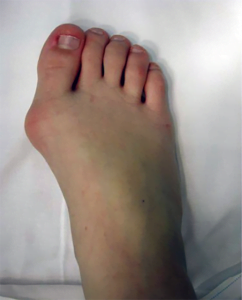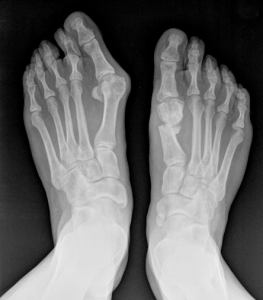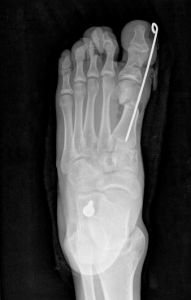Hallux Valgus (Bunion)
What is Hallux Valgus (HV)
 Hallux Valgus, also known as bunion, can occur both in adults and children (Juvenile Hallux Valgus).
Hallux Valgus, also known as bunion, can occur both in adults and children (Juvenile Hallux Valgus).
A bunion is a large bump at the base of the big toe where the joint connects the toe to the foot.
Usually hallux valgus deformity is most common among women but sometimes can occur in teenager, especially in 10 to 15 years old girls, more rarely can be congenital and present at birth.
What causes bunions?
The exact cause is unknown. It may be an inherited condition that tends to occur in families, but one of the most common causes includes wearing high heels or shoes that fit too tightly.
Also children with flat feet or with neurological disorders such as cerebral palsy are more likely to develop bunions (HV)
Bunions symptoms
The symptoms of bunions in young people may be as follows:
- swelling and redness around the base of the big toe joint
- pain wearing shoes and sometimes when walking
- a sore bump
- Corns or calluses where the first and second toes overlap
Bunions diagnosis
An orthopedic surgeon can diagnose hallux valgus during a physical examination checking foot alignment, mobility of the joint, walking patterns.
Bunion treatment
Hallux valgus treatment depends on the severity of the bunion and the pain it causes.
Non-surgical treatments

Non-surgical methods are the first thing to try.
People with bunions should switch to shoes that don’t compress the toe and don’t put too much pressure on the bump.
Also customized shoe inserts can help reduce pressure during movement and better position the foot inside the shoe.
When the bunion becomes inflamed, applying ice associated with non steroidal anti inflammatory drugs can help relieve soreness and pain.
Surgical treatment
Bunions surgery must be considered the last resort
In children and teenager surgery is not recommended unless the child experience severe foot pain that interferes with everyday activities.
There are different surgical procedures to treat bunions. Even if it is possible that patients will be able to walk immediately after surgery, full recovery can take several weeks.
How Prof. Portinaro treats Hallux Valgus

Prof. Portinaro is one of the most qualified surgeons in the world for foot diseases and treatments.
In his long-running career he has been treating bunions in adult and children always with a non-operative approach. But, since hallux valgus is one of the commonest forefoot deformity, he also performed more than 5,000 surgeries on people affected by this condition.
His technique is called PDO, Percutaneous Distal Osteotomy, a minimally invasive approach as a day case.
